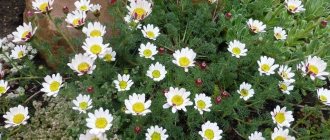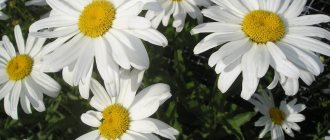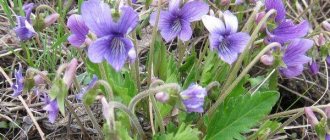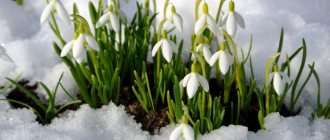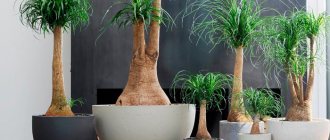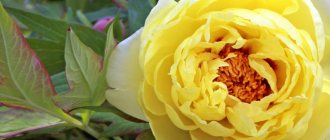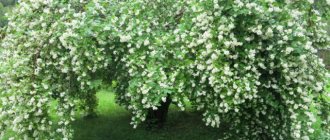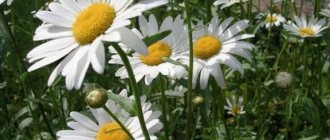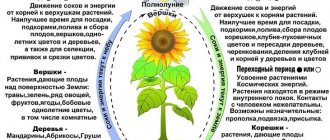Anacyclus
The plant really strongly resembles chamomile in appearance. The variety has about 10 subspecies , which are annual and perennial. The petals of the opened bud have a double color: they are white on the inside and pink on the outside. The flower reaches a diameter of 5 cm.
Basically, the varieties look like small bushes creeping along the ground. As a member of the aster family, anacyclus is subject to the solar rhythm: it opens at dawn and closes during sunset.
Chamomile, green and golden
The most famous type of chamomile is the chamomile, which is scientifically called Matricaria chamomilla. Its leaves are very small, simple, sessile with pinnately dissected venation. Knowledge of these features helps to distinguish the plant from species with similar inflorescences.
The leaves of true chamomile are similar to dill leaves.
The size of chamomile inflorescences is about 2.5 cm in diameter. There are two types of flowers in its basket. On the convex receptacle, which as the bush ages, takes on an almost conical shape, there are small yellow flowers with a simple perianth. White reed flowers grow along the outer contour of the receptacle, the number of which is usually 12 or 18 pieces.
At the moment of flowering, the chamomile bush looks like this:
Inflorescences similar in color combinations are found in odorless chamomile, some types of navels (including dog chamomile and field chamomile), Roman chamomile, some pyrethrums and tansy.
Chamomile belongs to the genus Matricaria, which includes only 25 plants. They are considered true daisies, while other plants are called that only in common parlance, having other names.
Most species of Matricaria are characterized by the same structure of inflorescences and a combination of only yellow and white flowers. The exceptions are green chamomile, which is also called fragrant or tongueless, and in the scientific community - Matricaria discoidea, and golden chamomile - Matricaria aurea.
The green inflorescences contain only tubular flowers, which, as the name suggests, are green in color. It has no edge “petals” at all. The plant is also distinguished by a strong specific smell and the small height of the bushes. As a rule, they grow to only 20-30 cm. As can be seen from the photograph, in appearance they are very different from chamomile bushes:
The golden chamomile is quite similar to this species. It differs from green mainly only in the color of the inflorescences, which in this plant is yellow. The diameter of the inflorescences is very small - no more than 0.8 cm, and the height of the bushes is about 25 cm. An important feature of the species is that flower baskets can grow singly, and not in corymbose inflorescences, as in most other representatives of the genus Matricaria.
Arctotis
A rather tall crop, which sometimes grows up to 130 cm. In difficult conditions, the flower develops poorly and grows only up to 25 cm. The species is divided into two subspecies: stochafolium and hybrid.
Both named subspecies are characterized by unusual buds with petals colored red or bronze at the center with a gradual transition to yellow. The buds open only in sunny weather, and you won’t be able to admire them in the rain.
Plants with colorful inflorescences
Some plants have multicolored inflorescences. Often 2-3, and sometimes even more, shades are combined on one petal. Thanks to this, the plants look very impressive and exotic.
It is also useful to read: All the medicinal properties of chamomile, both confirmed and unverified
Multi-colored daisies are called:
- Gaillardia spinosa;
- Osteospermum;
- Gazania;
- Venidium;
- Arctotis;
- Ursinia umbilicus and other similar flowers.
Gaillardia spinosa is a perennial shrub whose stem height reaches 90 cm. The diameter of the flower baskets is usually from 7 to 12 cm. The tubular flowers located in the center are dark red or burgundy in color. The petals of this plant are three-toothed. Along the outer edge they are colored yellow, and closer to the middle - red or purple. In some varieties they are arranged in several rows.
Gaillardia bushes look like this:
This plant is sometimes confused with helenium, some varieties of which have almost the same color of flower baskets.
Many varieties of osteospermum are also often called colored chamomile. Their inflorescences can combine a variety of shades: pink, white, red, lilac and others.
Here the photo shows osteospermum tricolor:
An abundance of color variations is also inherent in gazania. Its inflorescences are very large, and its petals are pointed. They can combine 3-4 color shades at once. The photographs show some plant varieties:
On a note
Gazania and osteospermum are often grown not only in open ground, but also in pots. Their bright inflorescences and long flowering period make them a wonderful home decoration. You can grow these flowers either from seeds or by purchasing seedlings. Their prices are much higher than for seeds, however, according to reviews, they almost always take root well.
Venidium boasts even larger and brighter flower baskets. Their diameter ranges from 10 to 14 cm, and the height of the bushes can reach 80 cm. Its reed flowers have pointed or rounded edges. They come in white, yellow, orange, red and some other colors. Moreover, in almost all varieties the center is black, and around it, on the edge flowers, a ring of a contrasting color is outlined - brown, burgundy or purple.
A similar color is found in Arctotis. Some varieties also develop a ring of a different color around the core. At the same time, its petals are more pointed, and the diameter of the baskets is slightly smaller.
Here the photo shows Venidium bushes:
And here is arctotis:
And this is Ursinia umbilicalis:
As can be seen from the photograph, its marginal flowers are colored at the base in a rich brown color, which gradually turns into burgundy, and then into bright orange.
Venidium
These are white, pink, orange or yellow flowers similar to daisies. They have a brown or dark red core. When open, the bud reaches 10 cm in diameter , and the length of the stem is between 70-80 cm. The species is rarely grown in open ground, more often it can be found in home pots and flowerpots. Flowering begins at the end of June and continues until the end of September.
Yellow daisies
Many other types of aster plants also have the inflorescence structure characteristic of daisies. Because of this, they are also often called daisies, adding an epithet to describe their color. Thus, many plants are popularly called yellow daisies, while such a term does not appear in the scientific community.
Without knowing the correct names, yellow daisies are most often called:
- Doronicum orientalis;
- Coreopsis;
- Rudbeckia;
- Erigeron linearis;
- Ursinia is beautiful;
- Helenium and some other plants.
- Doronicum eastern.
Its inflorescences are larger than those of daisies, and the marginal flowers are yellow or golden in color. The plant is perennial.
It is also useful to read: What are the benefits of chamomile tea for women?
The same color is found in some species of coreopsis. Moreover, the cores of these plants can be not only yellow, but also brown or burgundy. Their reed flowers, as a rule, have jagged edges.
These photographs show several species of coreopsis:
Terry coreopsis
Various types of rudbeckia are also called yellow daisies, among which there are both annuals and perennials. Among the latter, the most common is the brilliant rudbeckia, which is characterized by a tall stem and large inflorescences. The shrubs reach a height of 60 cm, and the diameter of their inflorescences is 8-10 cm. Their petals are bright yellow and velvety to the touch, and the center is dark brown.
In flower beds and gardens you can often find hairy rudbeckia. This is an annual bush plant, smaller in size than the brilliant rudbeckia. It also differs in the color of the marginal flowers. Along the outer contour they are yellow, and in the middle they are dark burgundy or brown, as in the photo below:
Here the photo shows a beautiful Ursinia:
This annual is similar to rudbeckia in the color of the marginal flowers, but differs in the height of the bushes, which does not exceed 30 cm. Because of this, it is sometimes called small-flowered yellow daisy.
Of the wild plants, yellow daisies are called Erigeron lineart. This is a low-growing perennial shrub, the height of which is no more than 20 cm. Its inflorescences are also small - from 1 to 2 cm in diameter. They grow one at a time on separate stems.
Some types of helenium are also called. They differ in the height of the stems, which can grow up to 160 cm. At the same time, the diameter of the inflorescences rarely exceeds 5 cm. The most characteristic color for them is yellow, but cultivated varieties also have brown and purple shades. Very often helenium can be found in flower beds along with daylilies and lilies.
There are a lot of plants that resemble yellow daisies. In addition, sometimes even flowers that have more different than similar features are called this way, for example, gerberas, large-flowered chrysanthemums and asters.
Gatsania
The flower has an incredible variety of shades: yellow, lilac, red, orange, etc. There are also two-color and striped varieties. Externally, gatsaniya really resembles a chamomile, only with brighter and more colorful petals. Gradient varieties, where one color gradually gives way to another, do not allow you to take your eyes off the bush.
Under natural conditions, there are about 40 species that are resistant to frost, direct sunlight, drought and high temperatures. Flowering starts at the beginning of summer and continues until night frosts. The height of the bush is within 30-40 cm. The flower retains its appearance for a long time after cutting.
Gatsania is grown in open ground, pots and flowerpots. It combines well with other plants in the flowerbed and looks impressive when planted alone. The species is used to decorate paths, borders and rock gardens.
Common varieties grown by breeders
Over the years of work, breeders have managed to develop many colored daisies that are distinguished by their excellent decorative properties. The most popular and widespread plants include:
- pyrethrum;
- osteospermum;
- Felice;
- doronicum;
- gatsaniya;
- echinacea;
- arctotis.
Many people are interested in what yellow daisies are called. There are quite a few species of such plants, but most often we are talking about Doronicum.
This is not a complete list of crops that are similar in flower structure to ordinary garden daisies. Each plant has its own botanical features and characteristics.
With a black center
Arctotis is considered one of the most famous multi-colored daisies. It is very similar to an ordinary garden chamomile.
The flower includes white petals and a black center with a yellow ring around it. The main difference between the culture is the very large size of the flowers.
Arctotis is a beautiful flower with a dark center.
With a brown center
One of the most popular and famous daisy-like flowers is the gerbera. It is often grown in summer cottages for cutting and arranging bouquets. The plant blooms until mid-August. The height of the crop reaches 70 cm.
The center of the flower is usually brown. In this case, the petals can have different shades. The culture is considered very unpretentious and can easily withstand winter cold.
Another type of colored daisies with a brown center is Venidium. It has yellow petals. The flowers reach a diameter of 10 cm. At the same time, the stems grow up to 70-80 cm.
There are varieties of Venidium with different petal colors. They can be white, pink or orange.
This plant is rarely found in gardens. Most often it is grown in pots or flowerpots. The flowering of the crop lasts from the end of July until the beginning of frost.
Venidium is a beautiful chamomile with a brown center.
Gatsania
This plant comes in many colors. The petals of such daisies are lilac, red, and orange. There are also varieties in which one tone gradually turns into another.
More than 40 varieties of gazania are found in nature. They are resistant to frost and drought. Low-growing bushes 30-40 cm in size are planted not only in open ground, but also in boxes or pots.
Doronicum
This is a perennial crop that has triangular foliage of a rich emerald color. The height of the bushes varies depending on the variety. It can range from 30 cm to 1 m.
The flowers have a yellowish-orange hue and reach a diameter of 6-10 cm.
After cutting, the flowers retain their appearance for a long time. That’s why they are often used to make bouquets and combine with other plants.
Coreopsis
The plant can have different types. Depending on this, its height can be 60-100 cm. In this case, the flowers reach 3-7 cm in diameter.
Coreopsis blooms begin in mid-July. This period lasts 60-80 days.
These small daisies can be regular or double. They have bright sunny colors - from pale yellow to rich orange. The culture looks best in large flower beds or front gardens.
Blooming coreopsis
Rudbeckia
A popular crop that looks like large daisies with dark brown stamens and a few yellow petals.
The plant is characterized by later flowering, which begins in the second half of August or September. Culture can become a real decoration of any autumn flower bed.
The height of rudbeckia depends on the variety and can range from 50 cm to 2 m. The petals most often have a yellow tint. However, pink, cream, and orange flowers are sometimes found.
Pyrethrum
The shape of the flowers of the plant is very reminiscent of cornflower and daisies. Its white varieties are easily confused with them.
At the same time, pyrethrum can have different shades - purple, lilac, crimson, pink. Some varieties of the plant are called Persian and Caucasian chamomile.
The culture reaches a height of 60 cm. It has pinnately dissected leaves of a rich green color. The flower basket of the plant does not exceed 6 cm in diameter. The culture is very popular among gardeners because it has a decorative appearance and is undemanding to care.
Caucasian chamomile pyrethrum
Other
Multi-colored daisies have many other varieties. They all differ in color, size and botanical characteristics. Popular garden crops include:
- Nivyanik - this plant resembles chamomile more than others. The culture is popularly called large or giant chamomile. This genus includes no more than 20 plants. The most popular representative is the largest cornflower. Its hybrids can grow up to 1 m in height. Beautiful terry varieties that have unusually shaped petals are considered even higher.
- Calendula - this plant is considered very popular. It is low maintenance. Culture belongs to the Astrov family and is considered one of its most widespread representatives. These orange daisies are characterized by different sizes. Low-growing varieties have a height of 20-30 cm, and tall varieties - 60-65. The advantage of calendula is the possibility of active reproduction by self-seeding.
- Helichrysum - this crop is characterized by grayish stems and leaves. Moreover, it has white buds. The bush does not exceed 10 cm in height, but has a large width - 45-50 cm. The flowering period of the crop lasts from June to August. It can be annual or perennial. The most common varieties of helichrysums include awl-leaved, bract-shaped, and helmet-shaped.
- Cosmea is a tall relative of daisies. Its stems reach a height of 70-150 cm. The plant often propagates by self-seeding and is distinguished by its low maintenance requirements and decorative appearance. In addition, cosmos are not afraid of wind and frost. It can grow even in poor and depleted soil. Today there are more than 20 types of this culture. Its flowers resemble pink, red, lilac, and white daisies.
- Echinacea - This plant has different shades. Breeders offer gardeners pink, crimson, white, orange, yellow, and greenish shades. The centers differ in the shape of a hemisphere and sometimes stand out significantly against the background of the petals. Echinaceas are characterized by smooth growth and long life expectancy.
Pyrethrum is a bright and low-maintenance flower.
Gerbera
The plant is similar in structure to a chamomile, but has purple, yellow, cherry, orange, cream and classic white petals. Such diversity attracts gardeners; resistance to adverse conditions, as well as wide possibilities for use in bouquets, also play an important role.
There are double gerberas, and their numerous petals are tubular, curly and pointed. The species is grown outdoors and at home. Flowering starts in the summer months and lasts until November. The exact dimensions of the bush and the open bud depend on the variety.
Caring for pericallis at home
Pericallises are very beautiful and showy. But they never became super popular indoor plants; and even today, despite their beauty, they are considered crops more for amateurs. This is explained very simply: pericallis requires conditions that are difficult to recreate in ordinary rooms. In order to admire its flowering, you will have to take care of a cool environment. And the need to constantly maintain high air humidity does not simplify the growing process.
This is a capricious beauty for those flower growers who are ready to fulfill all his requirements. After flowering, pericallises are thrown away; even if they try to save them for the next year, these hybrids do not bloom, and most often die in winter.
Lighting for pericallis
For a luxurious indoor baby, you will have to provide the brightest lighting. Pericallis is not very afraid of direct sunlight (except for midday); it will happily settle on a moderately sunny windowsill or in a bright place with diffused light. Several hours of sunshine a day have a positive effect on the number and size of flowers.
For pericallises in rooms, eastern and western window sills are most suitable; if the spring is not cloudy, pericallises also grow well on the northern window sill. This plant does not like artificial lighting and reacts poorly to fluctuations in light intensity during flowering.
Hybrid pericallis (Pericallis hybrida), or garden groundsel, or bloody Cineraria. © danziger Hybrid pericallis (Pericallis hybrida), or Garden groundsel, or Bloody Cineraria. © danziger
Hybrid pericallis (Pericallis hybrida), or garden groundsel, or bloody Cineraria. © danziger
Comfortable temperature conditions
The most difficult thing in growing pericallis is choosing a temperature that is comfortable for it. During the flowering period, for which it is actually grown, this plant will only be comfortable in air temperatures below 18 degrees Celsius. Budding, the formation of flower buds in a plant, occurs at a temperature no higher than 15 degrees.
The optimal temperature is from 10 to 15 degrees or about 15 degrees. Indicators can drop below 10 degrees only for a short period of time (but not below 4 degrees); ordinary room temperatures are not suitable for pericallis. Pericallis loves fluctuations in day and night temperatures.
Pericallis can be placed in a cool greenhouse, on a terrace or balcony. This plant loves fresh air and tolerates low temperatures well. It can be taken out into the open air for a day even in March. Pericallis can also be used as a garden plant.
Watering pericallis and air humidity
The watering regime for this plant can be called standard. Pericallises need stable humidity. Before the next watering, you need to let the top layer of the substrate in the pots dry. Drought and waterlogging equally negatively affect flowering, but if, during overwatering, quick correction of care and increasing the intervals between waterings allow you to compensate for the error, then after the soil dries out, the pericallis most often does not recover and withers very quickly.
It is much more difficult to provide the high levels of air humidity necessary for this summer. Pericallis will delight you with flowering only at air humidity of 60%. For a plant with velvety leaves and delicate flowers, the spraying method is not suitable, unless you use a fine nozzle and spray from a considerable distance. Pericallis prefers to install humidifiers or trays with wet pebbles and moss, on which the plant is placed so that the bottom does not touch the surface of the water.
Hybrid pericallis (Pericallis hybrida), or garden groundsel, or bloody Cineraria. © senetti
Fertilizers for pericallis
This plant blooms for a fairly limited period. If you get an ordinary pericallis that blooms in 1-1.5 months, then you don’t have to feed it. The supply of nutrients in the soil will be enough for this period. Varieties with enhanced flowering, which can last up to 4-6 months, require feeding similar to garden potted annuals.
Fertilizers for flowering plants are applied once every 2 weeks in a standard dosage or weekly in half the doses. Intensive fertilizing at the beginning of budding increases the flowering period. The plant responds well to long-acting fertilizers.
Pericallis pruning
This plant does not need any shaping: the cushion of leaves already looks very neat and attractive, and the flowering stems create a living bouquet above it without outside help. All you need to take care of is removing the faded flowers. They only spoil the attractiveness of pericallis (the plant does not clean itself, dry baskets spoil the impression of neighboring inflorescences). But don’t rush to just pinch off the daisies: pericallis needs to trim the wilted heads with sharp tools.
Transplantation and substrate
Since it is impossible to make pericallis bloom again, the plant is not replanted, and after flowering it is simply thrown away.
If pericallis is grown independently from seeds, then a universal substrate is used for it. The earth mixture should be light and loose, nutritious, and of high quality. For pericallises, a universal neutral or slightly alkaline soil mixture is suitable. Usually it is made up of equal parts of turf and leaf soil, sand and humus (1: 1: 0.25: 0.5).
Hybrid pericallis (Pericallis hybrida), or garden groundsel, or bloody Cineraria. © senetti
Doronicum
The second name of the species is Kozulnik. There are about 40 varieties, but often only 10 are used. The height of the bush varies in different varieties from 0.5 to 1 meter. The flowers are yellow and quite large - the diameter reaches 10 cm. Flowering begins in May and lasts on average 1.5 months. At the same time, the plant can be pleased with the repeated release of buds in mid-summer or early autumn.
When cut, the flower retains its attractive appearance for a long time. You should know that the plant is poisonous. It is not recommended to plant Doronicum under trees - it will be suppressed.
Blue daisies
Yellow daisies are perennial flowers
Blue flowers that resemble daisies are representatives of the genera Aster, Cineraria, and Osteospermum.
Aster
A garden flower loved by many. Gardeners are attracted by its unpretentiousness, simple agricultural technology, and rich palette of inflorescences. Currently, there are more than 600 hybrids and varieties of these flowers. Another name for aster is callistephus. China is considered its homeland. The flower appeared in Europe in the 18th century.
Aster
Aster features:
- stem height up to 50 cm;
- superficial tap root system;
- inflorescence - basket.
Sowing seeds for seedlings - until June 10. It takes 80-130 days from emergence to flowering; these figures should be relied upon when planting seedlings in open ground. Depending on when you want to see the first flowers, determine the time for planting the seedlings.
According to their lifespan, asters are classified as annual, biennial, or perennial. There are 12 main types of aster inflorescences. The most similar to daisies are the simple inflorescences of Zonenshain, Margarita, and Edelweiss. They have a center and large petals along the edge.
Varieties of asters similar to blue daisies:
- alpine blue aster;
- Baroness blue and white;
- Excellent Rackley;
- heather aster Blue Parade.
Cineraria
The genus Cineraria consists of 50 species. Translated from Latin, the name means “ashen”. These flowers come from Madagascar. Cineraria is cultivated as an annual or biennial.
The height of the bushes with heavily pubescent, pinnately dissected leaves is from 30 to 90 cm. Flowering from mid-June, until the onset of frost. The inflorescence is a daisy-like basket with a dark or yellow center and bright involucre petals.
Cineraria
Seeds for seedlings are sown in early April, in open ground - in mid-May. Used as borders, mixboards, in flowerpots and flower beds.
Varieties and hybrids bloom with blue “daisies”:
- Star Wars Blue Shades;
- Venice Blue Visa Ring;
- Venice Blue;
- Venice Delft Blue Visa Ring;
- Jester Blue Bicolor.
Osteospermum
A beautiful flowering herbaceous plant. The birthplace of the flower is South Africa, Somalia, and the Arabian Peninsula, which is why it is called African chamomile. Osteospermum is sometimes called Cape daisy or blue-eyed daisy.
The plant has the form of a bush up to 1 meter high. It blooms from the beginning of June until the onset of cold weather. The diameter of the inflorescences is 2.5-7.5 cm, they are open only when the sun is shining.
Varieties with blue petals:
- Sky and Ice;
- Starry ice.
Cape chamomile is used in borders, mixed flower beds, mixboards, and solitaire plantings.
Calendula (marigold)
The following daisy-like flowers are incredibly popular among people who have a local area. They belong to the Astrov family and are distinguished by their unpretentiousness to external conditions. Depending on the variety, the bush grows from 20 to 65 cm in height .
The open buds are quite compact, the petals are deep orange. Having planted marigolds in the garden once, you will not need to buy seeds for the next year - the plant actively reproduces by self-seeding, and if its spread is not limited, it will quickly occupy the entire free territory.
"Daisies" blooming in summer
This selection contains 7 garden flowers, similar to chamomile, that bloom in the summer - from June to August.
Anacyclus (anacilus)
It’s not surprising to mistake Anacyclus for a chamomile - it really looks surprisingly similar to this flower. In nature, there are more than a dozen species of this charming plant.
Anaciluses are both perennial and annual. The most commonly grown annuals in flower beds are Anacyclus clavaceae and Anacyclus radiata. The most common of perennials is Anacyclus depressum.
Blooms from late spring to mid-summer: from May to July.
Helichrysum daisy flower
Of course, it is difficult to confuse Helichrysum daisy flower with chamomile, but their inflorescences do have something in common.
There are several common perennial species of immortelle, but in gardens they are usually grown as annuals and biennials.
The most popular helichrysums in flower beds in the middle zone are bractose (popularly known as immortelle), awl-leaved, and helmet-shaped. More exotic ones are helichrysum coral-shaped, helichrysum Milfordova, helichrysum selago, etc. - at first it can even be mistaken for sedums.
Helichrysum daisy flower blooms in June-August.
Doronicum (kozulnik)
This yellow “daisy” is ideal for rock gardens and rockeries, because its homeland is mountains. Doronicum is a perennial plant. Height varies depending on the species. The smallest are Doronicum Altai and Doronicum Cluse, the height of their bushes starts from 10 cm. And the stately Doronicum Kolyumna, for example, can reach all of 80 cm.
It blooms from May to June or from July to August, depending on the species.
Nivyanyk
If you come across flowers that look like large daisies, it may be nivaria. Their inflorescences are not easy to distinguish from each other. In addition, the second name of one of the common species of this plant - common cornflower - is meadow chamomile.
In general, about two dozen species of nevus are known. Another popular species is the largest cornflower. A huge number of varietal wildflowers of this species are grown in flower beds. There are varieties with double and simple inflorescences, small or very large.
Most cornflowers are grown as perennials.
This plant blooms in the first half of summer.
Calendula (marigold)
Calendula, or marigold, is one of the most popular plants of the Asteraceae family, especially marigolds, a frequent visitor to flower beds in the middle zone.
Calendula is a charming flower, ideal for both flower beds and ornamental vegetable gardens. It reproduces well by self-seeding, and in a few years it will turn the corner of the plot allocated to it into a blazing yellow-orange sea.
There are both low-growing varieties of the Patio group (up to 20-30 cm) and numerous tall varieties (Goldkugel - up to 65 cm, Kanarienvogel - up to 60 cm, Yuvel - up to 50 cm, etc.).
Margarita
The daisy can be considered a cousin of the chamomile - these two plants are so similar. Of course, if we are talking about varieties with white flowers. But the daisy boasts a variety of colors: everyone is well aware of plants of this species with fuchsia, bright pink, and coral-colored petals.
Daisies bloom at the end of spring - beginning of summer.
Pyrethrum
Pyrethrum is indeed very easy to confuse with chamomile. Many of its species and varieties have saucer-shaped inflorescences with white petals and a yellow core.
Most often it is a perennial plant, but sometimes it grows as an annual.
One of the most common types of pyrethrum is pink pyrethrum. A large number of pyrethrum varieties with different petal colors have been cultivated: James Kelway (coral red), Brenda (deep pink), Bressineham Red (raspberry), etc.
Other species (for example, feverfew, feverfew) have white inflorescences.
This plant blooms in the first half of summer - in June - early July.
Coreopsis
The flower has yellow petals with a jagged edge and brown spots at the base. Pedicels grow up to 60-100 cm in height, depending on the variety. The diameter of the opened bud is within 3-7 cm. Flowering begins in mid-summer and lasts 2-2.5 months. Flower baskets can be regular or double, and the shade of the petals also varies.
The crop is suitable for growing in large front gardens and massive flower beds.
Chamomile-like flowers
You can often find flowers whose appearance resembles a chamomile. Even experienced flower growers sometimes find it difficult to determine the type of ornamental crop. The descriptions below will help you recognize the plant.
Felicia – flowerbed decoration
Blue daisies
Blue chamomile belongs to the category of plants of the Asteraceae family. Flowers are widespread throughout South Africa. Experts call the perennial felicia. In our climatic conditions, it is possible to grow the South African plant as an annual crop.
Note! Blue daisies are grown near borders, rocky gardens or along paths.
Landscape designers plant felicia in flower beds with beautiful yellow flowers. Blue chamomile inflorescences are used in the preparation of cosmetics. In appearance, Felicia resembles a white garden chamomile. Blue flowers contain purple hues and a yellow center.
The height of felicia reaches 25 cm. The stems are covered with a large number of small leaf blades. The diameter of the flowers is within 5 cm. Flowering is characterized by abundance and duration.
Aster
Aster belongs to the category of herbaceous perennials belonging to the Compositaceae family. There are almost 200 species in the genus. The leaf blades of the aster are simple. Bushes can grow up to 10-150 cm. The inflorescences consist of petals of various lengths, reminiscent of tongues in shape. They can be painted in various shades:
- white;
- pink;
- crimson;
- lilac, etc.
Interesting! Flowers like daisies are often grown along garden paths.
Cineraria
Cineraria is an ornamental crop characterized by bright flowering and silvery leaf plates. Plants are used by landscape designers to plant flowers and areas around the house. The colors of the petals can be very diverse, which allows each gardener to choose a plant to suit his taste. This unpretentious crop does not require complex care and can be grown at home. Flower pots are placed in the hall.
The height of the bushes can reach 35-90 cm. The tap root system is buried quite deep into the soil. The lyre-shaped petiolate leaf plates are naturally endowed with pinnately dissected outlines. On the surface of the foliage you can see soft fibers of a silver-blue hue. Flowering begins in mid-summer. At this time, the bushes are literally dotted with basket-like inflorescences, which can be either simple or double. Flowers can be painted in different colors:
- yellow;
- white;
- red;
- purple.
Flowering pleases the owner of the site almost until October.
Cineraria as a houseplant
Osteospermum
Osteospermum belongs to the category of herbaceous plants with large flowers. The second name for a flower similar to chamomile is African chamomile. During flowering, lilac-pink baskets with a purple central part bloom on the bushes. The African chamomile flower is characterized by long and abundant flowering. The herbaceous crop is grown as an annual. Strongly branching shoots can form a ball or grow rapidly upward. The height of the bushes is in the range of 100-145 cm. Oval leaf plates of oval shape are characterized by increased density.
Note! Scent glands are located on the foliage, due to which the plant emits a tart aroma.
White flowers similar to daisies
Below you can see the most popular white flowers, which resemble chamomile in appearance.
Anacyclus
Anacyclus belongs to the category of perennial or annual creeping crops, the height of which does not exceed 10-12 cm. As the flowers grow, a voluminous carpet is formed. The foliage of the plant is finely dissected. It is painted in dark green tones. You can admire the blooms throughout the summer. Bushes should be planted in well-lit areas with well-drained soil. For propagation, you can use the seed or vegetative method. Landscape designers plant anacyclus when designing rock gardens and ridges.
Orange daisies
Kozulnik is considered the best colored chamomile. The herbaceous perennial is endowed with a naturally fibrous superficial rhizome.
Doronicum (kozulnik)
Florists often call Doronicum sunny chamomile or roe. A representative of the Asteraceae family is widespread throughout North Africa. The culture does not require complex care. The unpretentiousness and vitality of the goat is the main advantage of the variety. Erect stems do not branch well enough. The height of the bushes can reach 35-100 cm.
Doronicum is a perennial herbaceous plant. It has a fibrous superficial rhizome. Strong, erect stems branch weakly. They grow 30-100 cm in height. Short pubescence can be seen on branches and leaf blades. The outermost parts of the stem foliage are covered with glandular formations. Yellow chamomile, whose name is Doronicum, is distinguished by the formation of single or grouped corymbose inflorescences.
Kozulnik
Pink daisies name
The most spectacular representative of pink daisies is considered to be pyrethrum, a description of which can be found below.
Pyrethrum
A perennial crop belonging to the Compositaceae family, it is distinguished by the formation of herbaceous shoots. The core of the flowers of this unpretentious plant is quite lush. Pyrethrum not only decorates the area, but also helps repel harmful insects. The perennial is endowed with a naturally fibrous root system. The length of erect herbaceous shoots reaches 55-70 cm. The foliage is pinnately dissected and colored in bright green tones. The diameter of the inflorescences is in the range of 30-60 mm.
On a note! The duration of flowering of pyrethrum (Caucasian chamomile) reaches 40-60 days.
Small daisies - what are they called?
The most popular small daisies are anemone and argyrantemum. Below is a description of each of these plants.
Anemone Blanda
Anemone Blanda belongs to the category of mountain flowers, which are common in the Caucasus and Asia Minor. Flowers are planted in nutritious limestone soil. The height of the plant barely reaches 20-25 cm. The carved foliage looks quite impressive. The diameter of the inflorescences is within 6-7 cm. Flowering duration is 21 days. The petals are painted in blue and blue tones.
Argyrantemum
Argyranthemum is often called daisy chrysanthemum. Experts distinguish about 20 species of plants. The shrub type is considered the most popular among gardeners. The height of the bushes reaches 30-100 cm. The pinnately dissected foliage is painted in silver or bright green shades. The flowering period begins in mid-summer. The shape of the petals is similar to a chamomile both in shape and color.
Helichrysum daisy flower
Helichrysum daisy flowering is an ornamental crop, the height of which does not exceed 8 cm. In the area of short peduncles, white inflorescences and small pubescent gray foliage are formed. Flowering begins in the first weeks of summer.
Helichrysum daisy flower
Mesembryanthemum
Mesembryanthemum is a plant that belongs to the class of succulents. The height of the bushes can reach 15-16 cm. The heat-loving crop should be planted in well-lit areas with sandy soil. The erect stems are highly branched. The leaf blades are planted quite densely and are painted in a pale green palette. The foliage is arranged in an opposite manner in the lower part of the bush and alternately in the upper area.
Big daisies
What are the names of the large daisies that can often be found in flower beds? It is worth considering descriptions of plants that fall into this category.
Gerbera
Gerbera is a bright representative of the Asteraceae family. Decorative culture prefers areas well lit by sunlight. Gerbera petals come in different shapes:
- tubular;
- pointed;
- curly
Petals can be painted in a variety of colors.
Cosmea
The plant often evokes associations of summer warmth and comfort. Its distinctive feature is its low maintenance and self-seeding. Once you remember what these colorful daisies are called and look like, they can be distinguished in private flower beds, as tapeworms on lawns, in city park areas and along borders. A lush carpet of greenery and bright buds will decorate the garden, covering bare areas of the territory and emphasizing straight lines.
The crop easily copes with prolonged drought and heat, is undemanding to the presence of various substances in the soil, and is resistant to frost. The petals come in many shades of red and purple, and white varieties are also found. The buds are located on straight stems growing within 0.7-1.5 meters. Cosmea is used as a tapeworm and in the company of other plants. If there are empty spaces in the flowerbed, this flower often saves the day, since it manages to easily and quickly cover all the flaws.
Pink daisies
Pink daisies are delicate and attractive. Let's look at some varieties.
Pyrethrum
Pyrethrum species are native to Europe, Asia and North America. Many representatives have antipyretic and anti-inflammatory properties. Most species are perennials. Stems height up to 1 meter, powerful root system. The diameter of pyrethrum baskets can reach 60 cm. The peak flowering of these colored daisies occurs in May-June.
Pyrethrum seeds are sown for seedlings in early March and planted on the site in early June. These flowers are used in group plantings, as tapeworms, and for cutting.
Varieties with pink petals:
- red pyrethrum or Caucasian chamomile;
- pink pyrethrum or Persian chamomile.
Pyrethrum
Nivyanyk
In fact, this is chamomile, namely its garden variety. Nilet belongs to the aster family and is often grown in our gardens. It is chosen due to the lack of special requirements for care, soil, and watering. It tolerates frost well. The bush grows up to 120 cm, the exact figures depend on the variety.
Flowering is accompanied by the opening of a white bud up to 10 cm in diameter with a yellow center. The process is repeated twice during the summer season: in May or June, and a second time in August or September.
What plants are most often confused with colored chamomile?
Classic chamomile is a perennial whose petals have a white tint. If there are colorful daisy-like plants growing in the garden bed, it is likely that they are gerberas. In appearance they are very similar to daisies. However, the petals of these flowers can have different shades. Thus, there are yellow, pink, purple, and crimson daisies.
Today there are several dozen varieties of gerbera. However, most of these plants are found in Madagascar and Africa.
Gerbera was first described by a scientist from Holland, Jan Gronovinus. This happened back in the eighteenth century. The botanist named this flower in honor of his friend Traugott Gerber. Subsequently, Carl Linnaeus, who systematized plants, used this name, indicating it in his works. Since the end of the nineteenth century, the crop began to be actively cultivated.
Gerberas are very similar to daisies and come in many varieties.
Like chamomile, gerbera is a perennial plant. Moreover, it is distinguished by leaves that have an elongated shape and a pointed end. The foliage grows from a basal rosette.
The flower stalks of this culture can reach a height of 60 cm. The flowers form single inflorescences in the form of baskets. Some varieties can reach a diameter of 30 cm.
Gerbera is characterized by a very long flowering period. Quite often, flower beds with these flowers retain their decorative value for several months.
Summer plants
In the garden you can plant many flowers similar to daisies, which continue to bloom all summer. Popular crops grown by many gardeners include:
- calendula;
- helichrysum daisy flower;
- daisy.
Thus, helichrysum is a flower with a yellow center and white petals. The main difference from chamomile is that its petals are strongly bent upward.
Daisy is a popular garden crop that has many types and varieties. There are varieties with white petals, which are very similar to chamomile. You can also use varieties of other shades to decorate your garden - there are quite a lot of them.
Calendula has a bright orange color.
Calendula is considered an equally popular plant that belongs to the Asteraceae family. It is characterized by a bright orange hue. Therefore, calendula serves as a decoration for any flower bed.
Nielberry, anemone, and heliopsis will help decorate the summer area. Doronicum, anacyclus, and helenium are also suitable for this purpose. All these daisy-like plants begin flowering at the end of May or in the first half of summer. At the same time, they retain their decorative effect until the beginning of autumn.
Blooming in early autumn
After the summer crops have finished flowering, the garden is decorated with plants that bloom in late August or early autumn. They are distinguished by a brighter and more saturated color of the petals.
The most common plants in this category include:
- gatsaniya;
- Venidium;
- arctotis.
Venidium is considered a rather exotic plant that is rarely found in temperate latitudes. It is characterized by bright orange flowers with white petals. The flowering of the plant continues until frost.
Gazania has a wide variety of shades. These flowers come in white, yellow, and pink. Multi-flowered plants look very beautiful. They can combine different shades - yellow with orange or white with purple. The culture is considered very unpretentious. At the same time, the plant blooms well, which is why it is often used in gardening.
Another common plant is arctotis. This flower most closely resembles a chamomile. It is characterized by simple white petals with a black center and a yellow ring around it. At the same time, the plant has fairly large flowers.
Gatsaniya can have a variety of shades.
In addition, in autumn gardens there are colorful flowers similar to daisies. These include gerberas, asters, and rudbeckias. Bacardi chrysanthemums and many other plants look very beautiful. They can have not only colored, but also white petals. However, gardeners often choose bright varieties. Among these crops there are orange, yellow, and crimson varieties.
It is difficult to imagine an autumn garden without chrysanthemums. Indian, autumn, and arctic varieties are similar to daisies. But to a greater extent this applies to the Bacardi variety. Such flowers can have a variety of shades - yellow, pink, red, purple. They are easy to care for and last a long time when cut.
Such crops differ in the height and size of the stems. They are not as small as daisies, and therefore attract a lot of attention.
Osteospermum
These flowers are exactly like daisies, only with purple or red petals. The varieties with white flowers are especially similar. It is recommended to plant in open areas exposed to direct sunlight. At the same time, osteospermum shows high resistance to life in regions where cloudy and rainy weather prevails.
The crop is grown in the form of annual or perennial plantings. The height of the bush varies between 25-100 cm, the opened bud reaches a diameter of 4-10 cm.
Brief description of chamomile
Chamomile is a botanical genus belonging to the large family Asteraceae, or Asteraceae, of the dicotyledonous class. The family unites more than 32 thousand species. Flowers similar to daisies can also be seen in other members of the family. It includes such genera as aster, doronicum, gerbera, pyrethrum, osteospermum, navel, three-rib, chrysanthemum, and cornflower.
Chamomile
A distinctive feature of representatives of the Aster family is the inflorescence. This type is called a “basket” and is formed by a flat, convex or concave receptacle on which the petals sit tightly. Inflorescence diagram: The receptacle is often surrounded by an involucre and a calyx formed by one or more rows of bracts. In the case of chamomile, which is familiar to us, small tubular flowers with five stamens form a yellow center, and the common calyx forms the white petals of the outer reed flowers.
All flowers, like daisies, have a specific inflorescence appearance with small flowers inside and brightly colored petals along the edge.
Pyrethrum
Another double of the chamomile, which is a highly branching bush, 20-50 cm high. The opening buds can reach 8 cm in diameter, their petals are colored white, pink, crimson, red and lavender. The flower is grown as an annual and perennial crop and has an effective ability to self-sow. Planting is possible in almost any soil, but waterlogging and stagnation of water should be avoided.
Flowering begins in May and continues for a long period. The aroma is strong and quite specific.
African daisy or gazania
The genus Gatsania includes about 40 species of herbaceous plants. In Europe, the flower appeared in the 17th century and bore the name “midday gold”, as it opened at noon.
Gatsania is an annual or perennial plant, about 30 cm high. The basal leaves are dark green and form a ground rosette. The diameter of the inflorescences can reach 9 cm. The petals are painted in a variety of colors and their combinations. Gatsania is grown through seedlings. Seeds are sown in the second half of March, and planted outdoors in late May-early June. Gatsaniya blooms from June to October. Each flower lives up to 20 days.
Types and varieties:
- Gatsaniya long-shoot;
- gatsaniya is harsh or shiny;
- gatsaniya Potsi;
- Gatsania peacock.
Landscape designers use gazania for mixboards and flower beds.
Gatsania
Rudbeckia
The flower belongs to the tall category, the minimum height of the bush is 50 cm, and the maximum reaches 2 meters. The plant has no special care requirements; moreover, it is perennial and can decorate the garden in one place for up to 5 years.
The daisy-like flowers come in yellow, pink, scarlet, orange and cream. There are two-color species, where the darker base becomes lighter as it approaches the edge of the petal. There are 40 varieties in total.
Echinacea or big chamomile
Echinacea is an unpretentious and bright flower, an excellent honey plant and decoration for any flower bed. It blooms from mid-July to mid-September. The Echinacea plant is unpretentious and prefers sunny places. They propagate by seedlings or buy an adult plant at garden centers.
American chamomile
Echinacea is also called American chamomile, as it comes from North America. The genus Echinacea unites 9 species; most often, gardeners give preference to Echinacea strange and Echinacea purpurea, as the most decorative.
Varieties:
- Cranberry Cupcake;
- The King;
- White Swan;
- Indiaca;
- Magnus.
Butterflies love to visit Echinacea; in addition, it is used in folk medicine as an immunomodulator.
Echinacea
Ursinia
The shape of the flower is similar to a chamomile, but the color of the petals is very different. They are mostly golden with a hint of orange. The color is bright and rich, easily attracting attention. It is noteworthy that the inside of the flower is lighter than the outside. For example, a petal that is yellow on the inside will be brownish-purple on the back. The opened buds have a diameter of 5-6 cm.
The shoots grow up to 30-60 cm, covered with dark green foliage. The crop is grown both annual and perennial. It is resistant to negative temperatures and is undemanding to living conditions. Flowering continues until night frosts appear.
Small daisies
There are many types of plants with small multi-colored daisies. The most common anemones found in flower beds are Bland's anemone, argyranthemum, helichrysum, and mesembryanthemum.
Anemone Blanda
A daisy-like primrose from the Ranunculaceae family. Another name is tender anemone. In the Russian Federation, wild anemone is listed in the Red Book.
Features of the plant:
- tuberous rhizome;
- bushes from 7 to 25 cm high;
- leaves are dark green, dissected;
- single daisy flowers;
- petals of blue, lilac, white flowers;
- flower diameter is 5-10 cm.
Anemone is a perennial, blooms for 3-4 weeks in April-May. Used in flower beds, alpine slides, borders. It goes well with other primroses: daffodils, primroses, and muscari will become excellent neighbors for the anemone. The flower is unpretentious, feels good both in the sun and in partial shade.
Anemone
Argyrantemum
Another name is daisy chrysanthemum. A profusely flowering shrub, its homeland is the Canary Islands. It blooms from July to October with a large number of small daisies. The color of the petals can be white, burgundy, blue, yellow.
Cultivated species of Argyrantemum:
- argyrantemum bush;
- argyrantemum adauctum;
- Argyranthemum broussonetii;
- Argyrantemum callichrysum.
Argyrantemum is a finicky plant, and it is difficult to create ideal conditions for it. The old parts of the shoots become lignified; the bush can reach 80 cm in height. It can be perennial if it is moved indoors for the winter.
Argyrantemum
Helichrysum daisy flower
Gardeners call helichrysum immortelle or tsmin. Its homeland is South Africa and the Australian continent. In the middle zone, these unpretentious plants bloom until the first frost. The peculiarity of helichrysum is that when cut, it can stand for up to a year, maintaining the bright color of the petals.
Appearance:
- ribbed stem up to 120 cm high;
- leaves are narrow, dark green, pubescent;
- basket diameter up to 7 cm;
- The petals are dry and curl into the inflorescences.
Gardeners grow about 30 species of immortelle. Most Popular:
- immortelle bract;
- helichrysum coral;
- Cmin Milfovidae;
- helichrysum daisy flower;
- sand tsmin;
- Immortelle angustifolia;
- Helichrysum Selago.
Helichrysum
Immortelle seeds for growing seedlings are sown in late March. The seedlings are transferred to the flowerbed at the end of May. The first flowers appear in mid-July. In landscape design, helichrysum is used for the background of mixboards, in rockeries along with lobelia, eschscholtia and sedum.
Mesembryanthemum
One-year or two-year succulent from the Aziz family. Most often these are low, creeping or creeping plants no more than 15 cm high. Fleshy sessile leaves are spindle-shaped or round in shape. Mesembrantheum flowers look like colored daisies with white, pink, and red petals.
It is grown through seedlings and planted in open ground in late May-early June. The flower does not like waterlogging.
Types and varieties used by flower growers:
- mesembryanthemum crystal: variety Iskorki;
- Harlequin variety;
- Limpopo variety;
In landscape design it is most often used as a ground cover plant.
Mesembryanthemum
Chrysanthemum
A perennial or annual plant with many varieties. Flowers are located on a separate stem or are included in massive inflorescences. The petals are cream, lilac, yellow, purple and lilac. The height of one branch varies depending on the variety, in rare cases it can grow up to 160 cm. The plant is stable after cutting.
The chrysanthemum variety Bacardi deserves special attention. You should remember the name and look at the photo, because chamomile-like flowers can be used to create a wide variety of compositions. The variety has white, densely set petals and a yellow center, which together gives an incredible similarity. There are up to two dozen buds on one large stem, so literally 3-5 branches allow you to form a lush, beautiful bouquet.
In addition to the standard color, the petals can be red, yellow, pink, or cream. This flower is popular among florists - its inflorescences are painted in various shades, sprinkled with sparkles, and decorated with ribbons.
The Bacardi variety is grown outdoors and at home. It is placed on sunny lawns and provides abundant watering.
Blue and lilac flowers
Aster plants have inflorescences with lilac and blue flowers. Without knowing the correct names, they are also called daisies. Most often it is called this:
- Pyrethrum;
- alpine aster;
- Felicia;
- Anemone;
- Catananche and some other plants.
Pyrethrum inflorescences are most similar to chamomile. Their structure is practically the same, only the size of the flower baskets and the color of the reed flowers differ. In some species they are bright lilac in color.
Alpine aster inflorescences have a yellow center, and the petals have a light lilac color. Their size and quantity are much larger than those of chamomile. In aster, reed flowers grow in 2 or 3 rows, making the inflorescence appear large and fluffy.
Several varieties of Felicia are called blue daisies. This is a small perennial shrub that produces a lot of inflorescences. In some varieties, the tubular flowers are yellow, and the marginal flowers are blue or lilac. There are also varieties with a bright blue core and blue petals.
Here the photographs show felicia ameloid shrubs:
...and bergers
And this is a tender anemone:
It has longer tubular flowers that are yellow in color and have blue-violet marginal flowers. They grow on single stems, about 20 cm high. Although the anemone is called chamomile, it not only belongs to a different genus, but also belongs to another family - Ranunculaceae.
Catananche flower baskets have a very beautiful bluish-lilac color. Their reed flowers are arranged in 3-5 rows, making the inflorescence appear larger and fluffier. The edges of the flowers are jagged, and at the base their color changes from light blue or lilac to purple.
Echinacea
A perennial with properties beneficial to the human body. There are only 10 types of Echinacea, the most popular of which is purple. Its petals can be not only purple, but also red, cream and yellow. The daisy-like flowers consist of slightly downturned petals and a convex center.
The height of the stem in some cases reaches 140 cm. Reproduction occurs by seed and vegetative methods. Flowering begins in mid-summer and continues until September. The plant produces buds from the second year of life.
It is recommended to plant in sunny areas; shade and even partial shade are unacceptable. There are no special requirements for the soil; only light sandy soil will not work. Echinacea grows in one place for about 5 years, then a transplant will be required.
Orange daisies
Flowers are like roses, but not roses - what are they called?
Flowers with orange daisies, similar to suns, will decorate any flower bed and bouquet.
Doronicum (kozulnik)
This genus includes up to 70 species. Doronicum is a mountain dweller. In the mountainous regions of Eurasia it is found at altitudes of up to 3.5 km. Kozulnik has been known in culture since the 16th century. The herbaceous perennial plant forms bushes covered with bright flowers with yellow petals and centers.
The planting recipe is simple: sow seedlings in early April and transfer them to open ground in early June. Light-loving plant, tolerates slight shading. Usually there are two waves of flowering per season: at the beginning of summer and in the second half.
Popular types and varieties:
- Doronicum Austrian;
- Doronicum Altai;
- doronicum oriental variety Gold Dwarf;
- Spring Beauty variety;
- Little Leo variety.
- Excelsium variety
Used in alpine slides and as a free-standing plant.
Doronicum
Planting a plant
Gerbera/Gerbera indoor
Slightly acidic soil is best suited for growing home gerberas. Leaf soil, formed when fallen leaves rot, has a good structure and a sufficient amount of necessary acids. Such soil is not as nutritious as humus, but it is easier for thin and delicate roots to take the necessary nutrients from it. Air-permeable lumps of leaf soil have good hygroscopicity.
The pot in which you plan to grow the gerbera must also be breathable, so it is advisable to use clay products.
Gerbera propagation occurs by seeds or vegetatively, through dividing the bush and cuttings. It is better to plant seeds in spring in leafy soil with a small sand content. Planting depth is about 5 mm. Transplantation into separate pots occurs when 3-4 true leaves are formed. Under favorable conditions, about 11 months pass from sowing to flowering of home gerbera.
Video “Sowing gerbera seeds”
Diseases of indoor gerbera
A healthy plant, which receives adequate amounts of moisture, light and the necessary nutrition, is rarely subject to characteristic diseases. Lack or excess of micronutrients, violation of the watering regime, and exposure to pests cause indoor gerbera disease, caused by a decrease in protective properties. A weakened plant is unable to fight fungal infections. For home gerberas, the greatest danger is powdery mildew and mold.
Powdery mildew is a disease caused by microscopic fungi . The mycelium of the parasite has a characteristic white color and spreads over the surface of the home plant, forming a peculiar coating similar to flour. The fungus draws nutrients from the gerbera, interfering with the process of photosynthesis. The main cause of this disease is a violation of the watering regime, leading to a decrease in the immunity of the gerbera. In addition, the fungus can develop in conditions of excess nitrogen.
Gray and white mold develops in conditions of high humidity and infrequent ventilation of the room. on the soil and parts of the plant. Spores of the parasitic organism travel through the air and may be found in irrigation water. To prevent mold damage, periodic disinfection of surfaces with solutions containing insecticides is used.
Cineraria
These flowers are very famous due to the fact that their bushes are low-growing, and all the inflorescences during the flowering period form a real flowering ball:
Due to this, and also thanks to the bright multi-colored edge flowers, they are often used for street landscaping, planted along borders or as decorations in summer cottages.
Cineraria in an ensemble with other decorative flowers.
Despite the fact that both the shape of the bushes and the shape and brightness of the inflorescences of cineraria differ well from daisies, without knowing their very original name, they are named by analogy with their more well-known relatives.
Flowers of the genus Pyrethrum
In addition to the “daisy-like” pyrethrum corymbosa and feverfew, the genus Pyrethrum includes many plants that, although similar in appearance to typical daisies, are just as easily distinguished from them.
For example, Dalmatian chamomile is widely known:
Its inflorescences are larger in size than the inflorescences of chamomile, and the receptacle in its flowers is flat, not so convex.
Also notable is the Persian chamomile, which has red or pink marginal flowers:
The baskets of these plants are also large and different in size from the inflorescences of typical daisies.
Typical representatives of the genus Chamomile do not have such flowers in the coloring of inflorescences at all, which does not prevent this species from being called “red daisies”.
It is noteworthy that all plants of the genus Pyrethrum are perennials, unlike the annual typical daisies.
